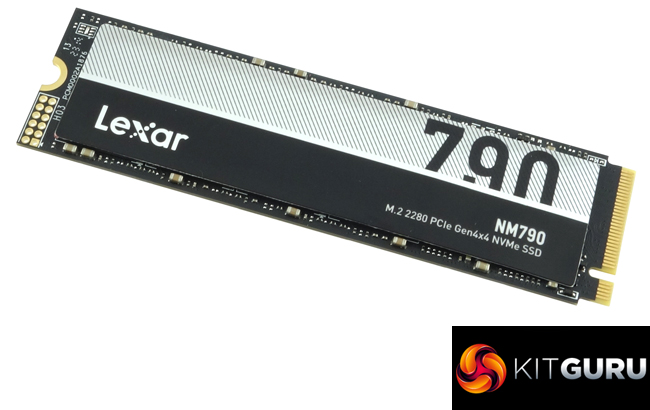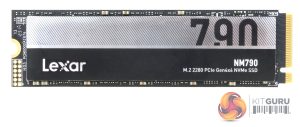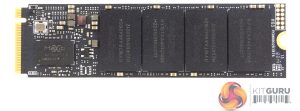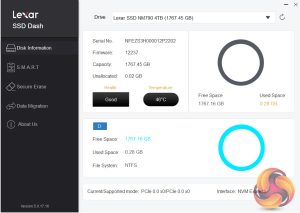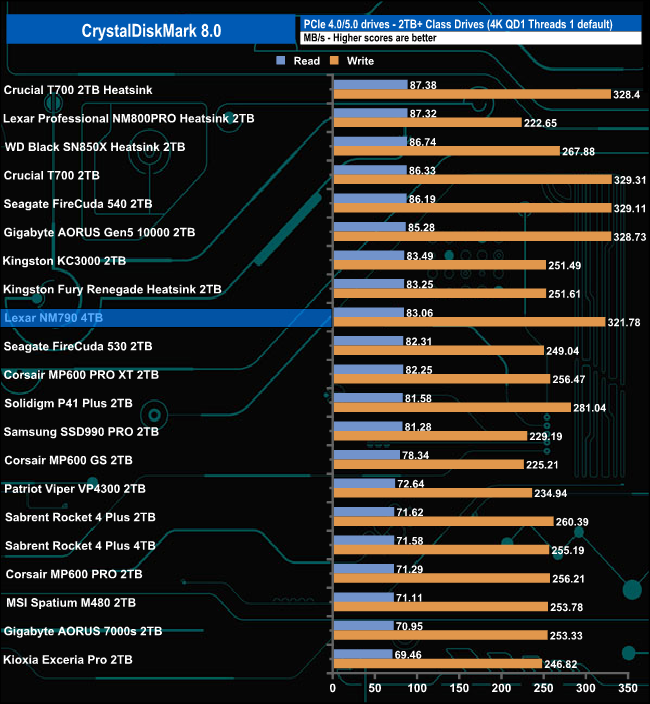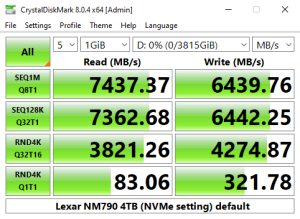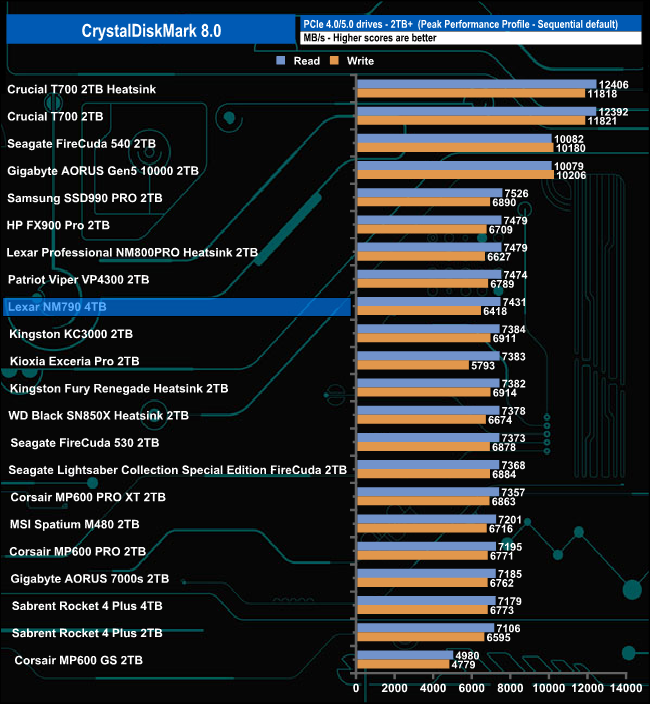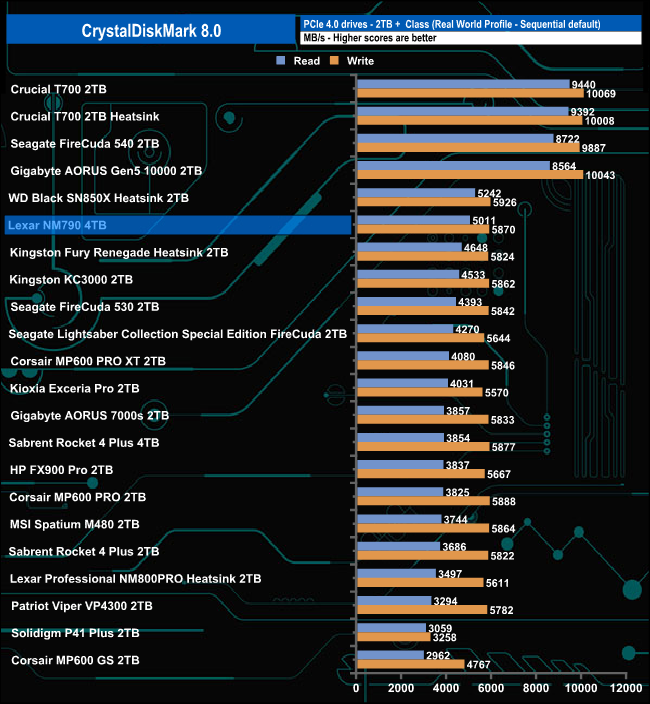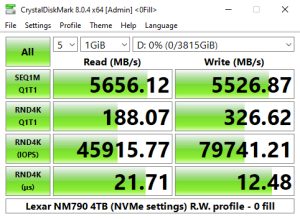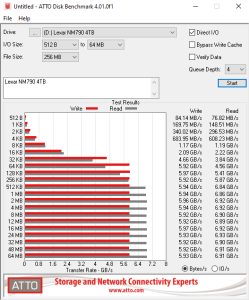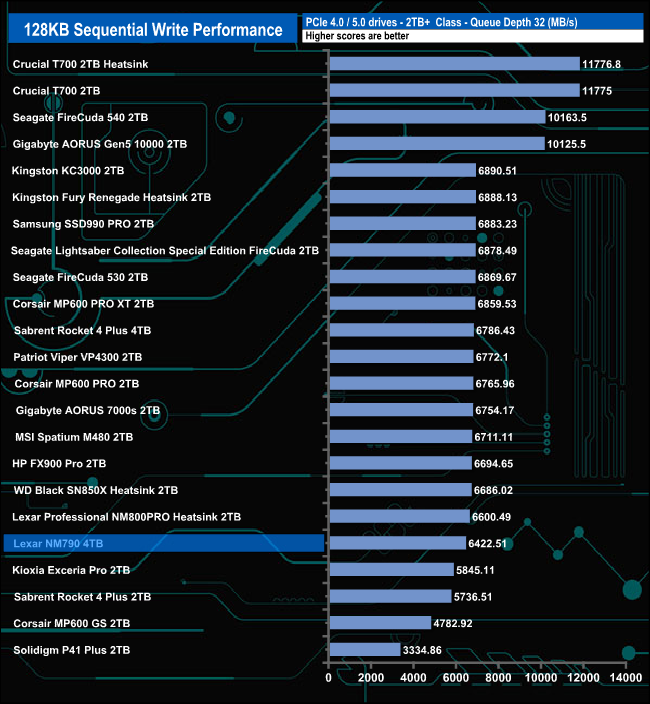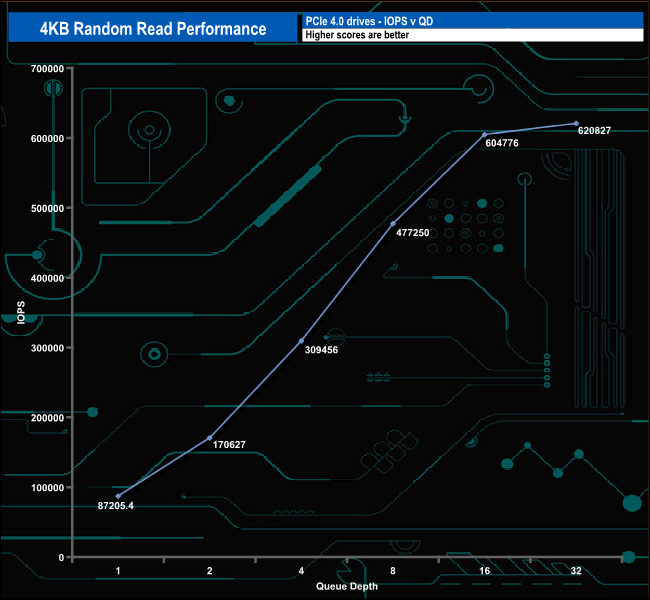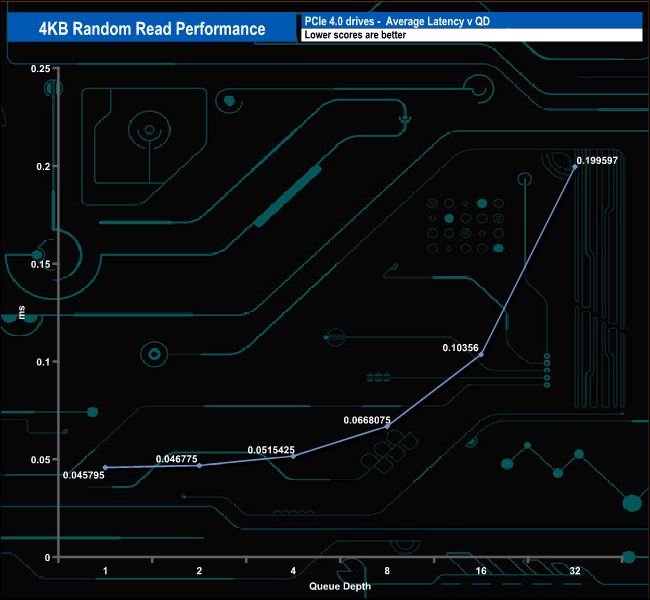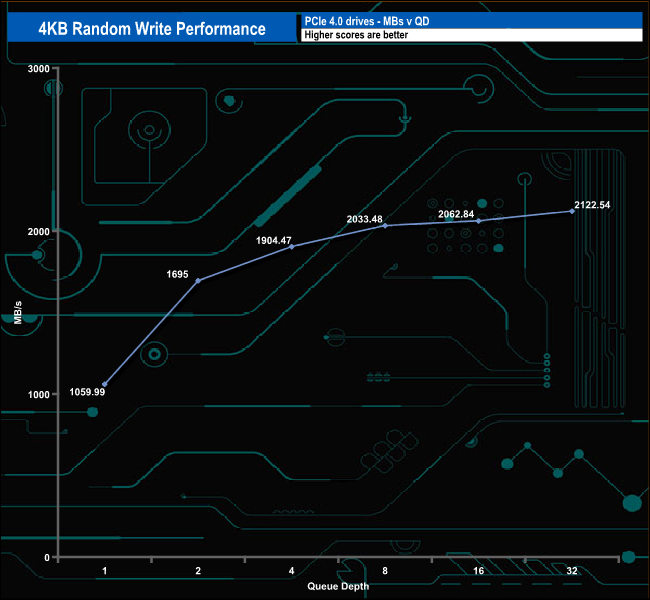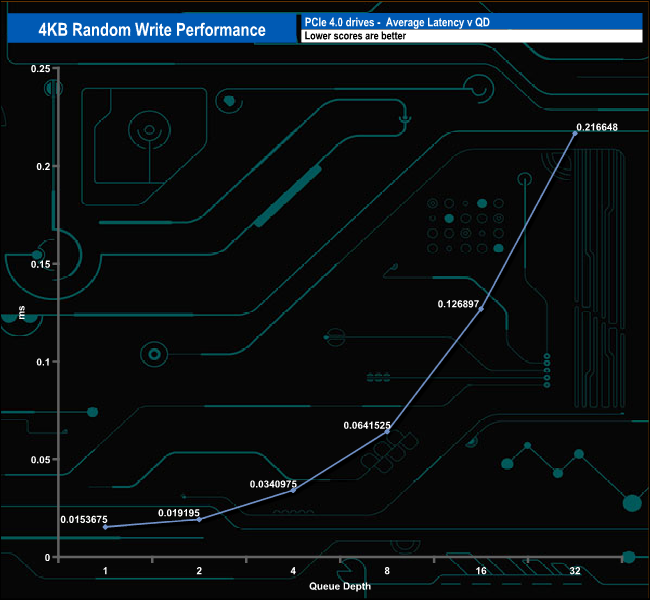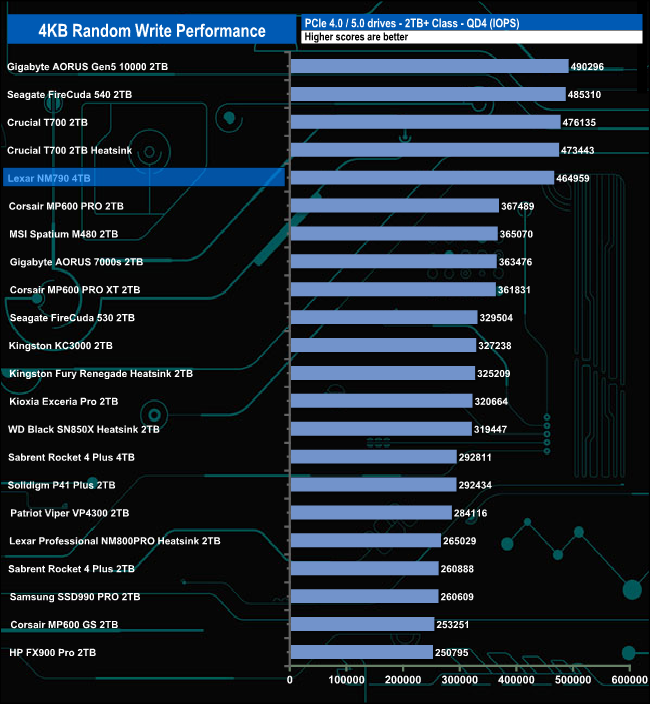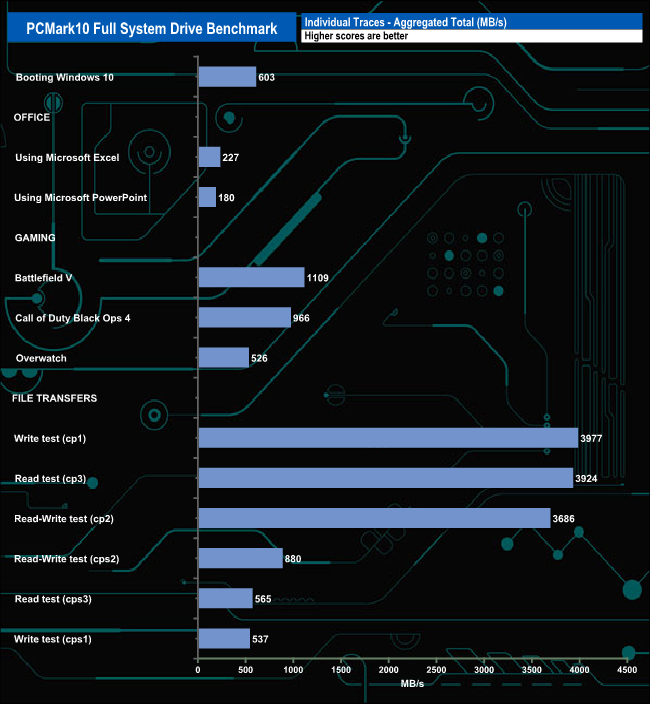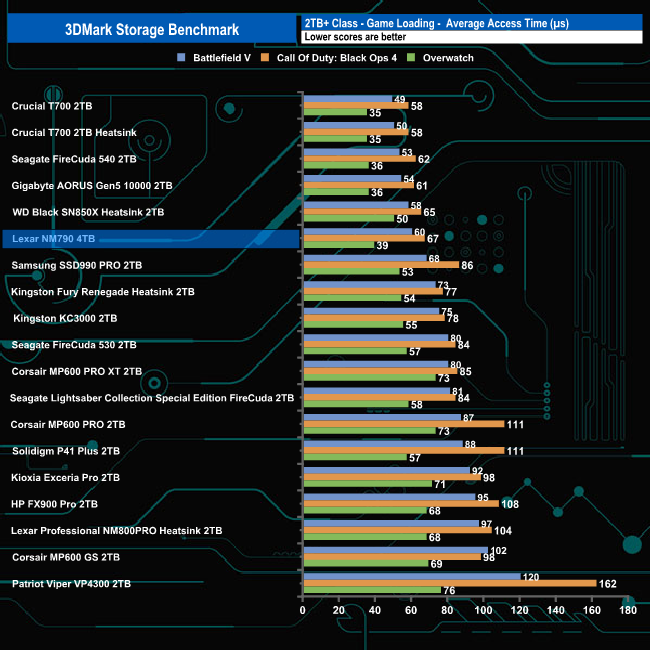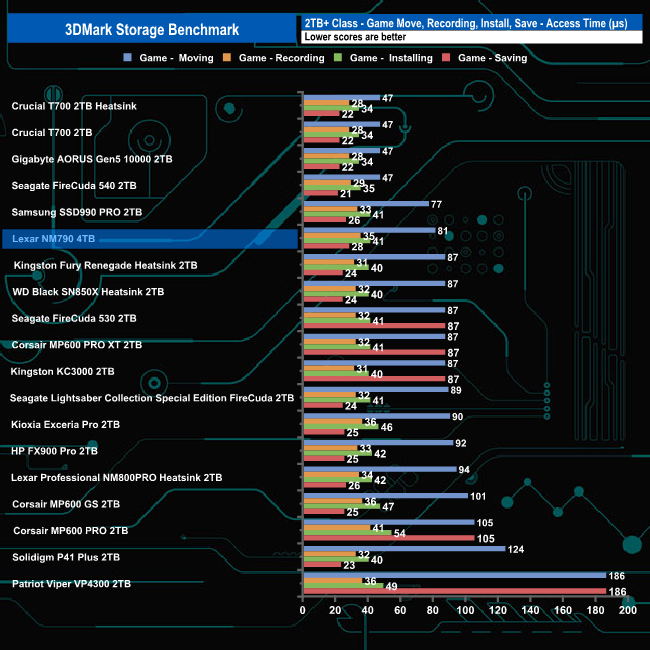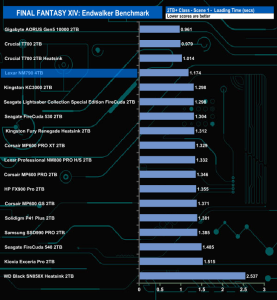
One of Lexar's latest additions to their range of gaming products is the NM790 SSD, a PCIe Gen 4 x4 drive offering speeds of up to 7,400MB/s for reads and 6,500MB/s for writes. With the 4TB model on sale for less than £200 here in the UK, is it worth picking up?
The NM790 comes in four capacities; 512GB, 1TB, 2TB and the 4TB flagship drive we are looking at here. It uses a controller that is new to us in the shape of a Maxiotech MAP1602A. The MAP1602A is a 4-channel DRAM-less design controller but unlike other DRAM-free controllers, this one has a 2,400 MT/s bus which means improved performance combined with better power efficiency. Instead of using DRAM, the drive uses Host Memory Buffer (HMB) 3.0 technology (the drive uses a small portion of the system memory in place of a dedicated DRAM IC) along with Dynamic SLC caching. For the NM790 Lexar has paired up the controller with Longsys branded 232-Layer 3D TLC NAND.
Lexar quotes Sequential performance across the range as up to 7,200MB/s and up to 4,400MB/s for read and writes respectively for the 512GB entry-level model while the other three capacities all have the same up to 7,400MB/s read and up to 6,500MB/s writes ratings. Lexar hasn't disclosed any random performance figures we have seen but the controller supports up to 1,000K IOPS for both read and writes.
The endurance of the 4TB drive is quoted as 3,000TBW and Lexar backs the drive with a 5-year warranty,
Physical Specifications:
- Usable Capacities: 4TB.
- NAND Components: 232-Layer 3D TLC.
- NAND Controller: Maxiotech MAP1602A 4-channel.
- Cache: none, Host Memory Buffer (HMB) 3.0.
- Interface: PCIe Gen4 x4
- Form Factor: M.2, 2280.
- Dimensions: 80 x 22 x 2.45mm.
- Drive Weight: 6g.
Firmware Version: 12237.
Lexar's NM790 comes in a black and silver finished box with a clear image of the drive on the front. Above the image and to the right, the drive's name is printed in silver which makes it stand out. Below the image of the drive is the Sequential read speed rating and to the right of this is a sticker highlighting the 4TB capacity.
The rear of the box has a narrow clear plastic window to display the drive above which are multilingual notes about the drive's performance and power consumption. Under these are multi-lingual instructions to find additional warranty and drive information. To the left-hand side of the window, there are yet more multilingual notes, this time talking about the drives speed rating.
Lexar's 4TB NM790 drive is built on a single-sided M.2 2280 format. The front of the drive is covered by a label that incorporates a metal foil to help get rid of the heat from the drive but it is very thin, but still, it's better than nothing. The rear of the drive has a standard label.
Being a single-sided design, all the major components sit on one side of the PCB. Along with the controller, there are four packages of 232-Layer 3D TLC NAND (coded Longsys RY18TAA48421024).
The NM790 uses a controller that is new to us, the MAP1602A from Maxiotech. The 1602A is a 4-channel, DRAM-less design built on a 12nm TSMC process with ARM Cortex-R5 architecture. Unlike many other DRAM-less design's the 1602A uses a 2400 MT/s interface speed. The controller supports up to 4TB of TLC 3D MLC/TLC/QLC NAND and uses MAXIO Agile ECC 3 Technology for error correction.
Lexar’s SSD management utility is called SSD Dash. It’s not as fully featured or flashy as some of its competitors, but it does offer all the basic information you might need to keep an eye on your drive in an easy-to-understand way. It also supports Secure Erase and data migration.
For testing, the drives are all wiped and reset to factory settings by HDDerase V4. We try to use free or easily available programs and some real-world testing so you can compare our findings against your own system. This is a good way to measure potential upgrade benefits.
Main system:
AMD Ryzen 7 7700X, 32GB DDR5-6000, Nvidia GeForce RTX 3050 and a Gigabyte AORUS X670E Xtreme motherboard.
Other drives
PCIe Gen5 2TB+
Crucial T700 2TB
Crucial T700 with Heatsink 2TB
Gigabyte AORUS 10000 2TB
Seagate FireCuda 520 2TB
PCIe Gen4 2TB+
Corsair MP600 GS 2TB
Corsair MP600 PRO 2TB
Corsair MP600 PRO XT 2TB
Gigabyte AORUS 7000e 2TB
HP FX900 Pro 2TB
Kingston Fury Renegade Heatsink 2TB
Kingston KC3000 2TB
Kioxia Exceria Pro 2TB
Lexar Professional NM800PRO Heatsink 2TB
MSI Spatium M480 2TB
Patriot Viper VP4300 2TB
Sabrent Rocket 4 Plus 2TB
Sabrent Rocket 4 Plus 4TB
Samsung SSD990 PRO 2TB
Solidigm P41 Plus 2TB
Seagate Lightsaber Collection Special Edition FireCuda 2TB
Seagate FireCuda 530 2TB
WD Black SN850X Heatsink 2TB
Software:
Atto Disk Benchmark 4.
CrystalMark 8.0.0.
AS SSD 2.0.
IOMeter.
UL Solutions PC Mark 10.
UL Solutions 3DMark Storage Benchmark.
Final Fantasy XIV Endwalker Official Benchmark.
All our results were achieved by running each test five times with every configuration this ensures that any glitches are removed from the results. Trim is confirmed as running by typing fsutil behavior query disabledeletenotify into the command line. A response of disabledeletenotify =0 confirms TRIM is active.
CrystalDiskMark is a useful benchmark to measure the theoretical performance levels of hard drives and SSDs. We are using v8.0.
Using the CrystalDiskMark 4K QD1 1thread benchmark, the read score of 83.06MB/s for the Lexar NM790 is a little slower than the last Lexar drive we looked at, the heatsink version of the Professional NM800 Pro, but the write performance of the NM790 is significantly faster.
Looking at the benchmark result screens, we can confirm the official Sequential ratings of the drive of up to 7,400MB/s and up to 6,500MB/s for read and writes respectively with a best read test figure of 7,437MB/s and a best write result of 6,439MB/s. Although the write result doesn't hit the official maximum it certainly is in the ballpark.
Those Sequential test results of 7,437MB/s and 6,439MB/s for read and writes respectively are good enough to see the drive in the top five of the Gen 4 consumer drives we've tested to date.
Peak Performance Profile
Again we could confirm the official figures with the Peak Performance profile test although this time the write result of 6,418MB/s was further off the official 6,500MB/s maximum rating.
We haven't seen an official 4K random performance rating for the NM790 but the controller supports up to 1,000K IOPS for both read and writes. Using the Peak Performance profile test we saw a best-read result of 931,606 IOPS, slower than the controller rating with writes at 1,048,635 IOPS, a little faster than the official figure,
Those 4K random read/write figures are the fastest we've seen to date for a Gen 4 x4 consumer drive by quite some margin.
Real World Profile
In the Real World profile default tests, the NM790 produced Sequential read/write figures of 5,011MB/s and 5,870MB/s respectively which makes it the second fastest Gen4 drive we've seen to date in this test behind WD's Black SN850X Heatsink model.
The ATTO Disk Benchmark performance measurement tool is compatible with Microsoft Windows. Measure your storage system performance with various transfer sizes and test lengths for reads and writes. Several options are available to customize your performance measurement including queue depth, overlapped I/O and even a comparison mode with the option to run continuously. Use ATTO Disk Benchmark to test any manufacturer's RAID controllers, storage controllers, host adapters, hard drives and SSD drives and notice that ATTO products will consistently provide the highest level of performance to your storage.
We are using version 4.1 for our NVMe disk tests.
Using the ATTO benchmark, we couldn't hit the official maximum figures of 7,400MB/s for reads and up to 6,500MB/s for writes with test results of 6,920MB/s and 5,960MB/s for reads and writes respectively.
Using the ATTO benchmark, the read performance began to slowly plateau out at 1MB (6,8400MB/s), but the write performance levels off way before that, at the 64KB mark with a figure of 5,920MB/s.
AS SSD is a great free tool designed just for benching Solid State Drives. It performs an array of sequential read-and-write tests, as well as random read-and-write tests with sequential access times over a portion of the drive. It uses
incompressible data samples which many drives struggle with, so results can be viewed as the worst-case scenarios.
AS SSD includes a sub suite of benchmarks with various file pattern algorithms but this is difficult in trying to judge accurate performance figures.
With an AS SSD read score of 3334, the 4TB version of Lexar's NM790 is the fastest Gen4 consumer drive we've seen to date. However, its write score of 4560 is even more impressive.
We used CrystalDiskMark 8‘s custom settings to test the Sequential read and write performance of the drive through a range of queue depths. The setup for the tests is listed below.
128KB Sequential Read / Write.
Transfer Request Size: 128KB, Thread(s): 1, Outstanding I/O: 1-32.
In this test, we couldn't quite hit the official maximum Sequential read and write speeds of 7,400MB/s and 6,500MB/s respectively with a best-read result of 7,274MB/s and a best-write figure of 6,422MB/s.
128KB Sequential Read v QD compared
The best read performance for the NM790 in relation to the drives around it comes at QD's 2 and 4 where it sits just behind WD's Black SN850X Heatsink model towards the top of the results chart. At QD1 it sits in mid-table and at QD32 it has fallen further down the chart.
128KB Sequential Write v QD compared
At QD1 the NM790 is the fastest consumer Gen4 we've seen to date. But as the QD deepens the drive's performance drops away so by QD32 it's in the bottom half of the results chart.
We used CrystalDiskMark 8‘s custom settings to test the 4K random read performance of the drive through a range of queue depths. The setup for the tests is listed below.
Transfer Request Size: 4KB, Outstanding I/O: 1-32.
We haven't seen any official 4K random performance figures for the NM790 but the Maxiotech controller is rated as up to 1,000K IOPS for random reads. Using our 4-threaded tests we couldn't get close to that figure. The best we saw was 620,827 IOPS.
4K Random Read v QD Performance
With 4TB of fast NAND running at a full 2400 MT/s interface speed the drive produced the fastest speeds at QDs 1, 2 and 32 we've seen to date for any consumer drive. At QD4 it is still the fastest Gen 4 drive but is outstripped by all the Gen 5 drives we've tested.
We used CrystalDiskMark 8‘s custom settings to test the 4K random write performance of the drive through a range of queue depths. The setup for the tests is listed below.
Transfer Request Size: 4KB, Outstanding I/O: 1-32.
Just as with the random read performance, the controller of the drive is rated as up to 1,000K IOPs for random writes. As with the random read results with our 4-threaded tests, we couldn't get close to this figure with the best test result of 518,199 IOPS at QD32.
4K Random Write v QD Performance
Despite not being able to match the official maximum figure, the test results for the NM790 make it the fastest consumer Gen4 drive we've seen to date for random write performance.
We used CrystalDiskMark 8’s custom settings to test the 4K 70/30 mixed read/write performance of the drive through a range of queue depths using a single thread and four threads.
Using four threads in our 70/30 read/write tests, the performance of the 4TB NM790 ranges from 100,025 IOPS (409.704MB/s) at QD1 to 575,081 IOPS (2,355MB/s) at QD32 where the performance rate of increase starts to slow down. Switching over to a single thread the performance runs from 23,905 IOPS (97.91MB/s) at QD1 up to 221,288 IOPS (906.39MB/s) at QD32.
We used CrystalDiskMark 8 to test the random performance of the drive at lower queue depths (QD1 – QD8 where most of the everyday workloads occur) using 1 to 4 threads.
Random Read
In the random read tests, all four of the tested threads displayed smooth increases in performance as the queue depth deepened with no nasty shocks. At QD1 the drive speed ranges from 19,771 IOPS (80MB/s) using a single thread up to 87,205 IOPS (357MB/s) using four threads. At a QD of 8, the single-thread performance had increased to 160,274 IOPS (656MB/s) while the four-threaded test reached 477,250 IOPS (1,954MB/s).
Random Write
In the 4K write tests, the performance rose quickly from QD1 to QD2 for all four tested threads with the fastest rise seen in the four-threaded test. All four threads see the rate of increase in performance start slowing from QD2 onwards up to the end of the test run at QD8. QD1 performance ranges from 78,657 IOPS (322MB/s) using a single thread up to 258,787 IOPS (2,033MB/s) using four threads.
In our read-throughput test, the drive peaked at the end of the test at 6,040MB/s, some 1,360MB/s short of the official maximum figure of 7,400MB/s.
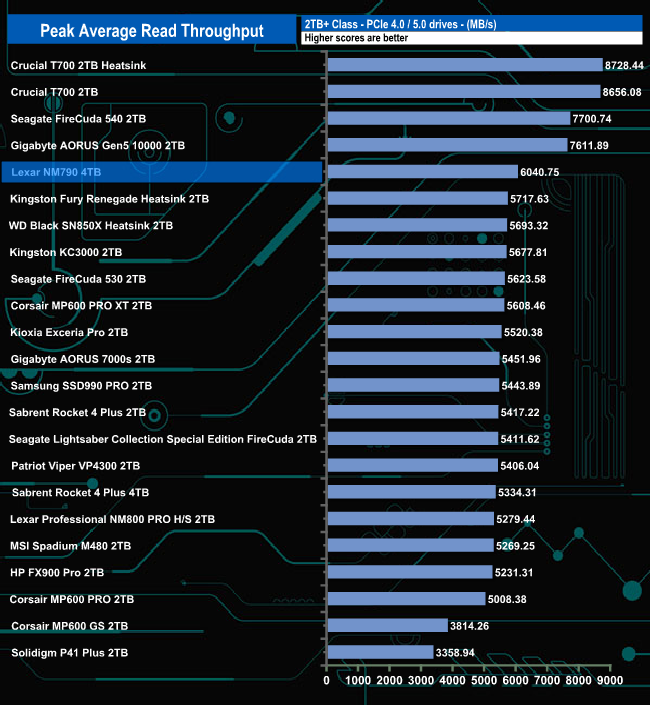
Even though the peak test result figure of 6,040MB/s is well short of the official maximum for the drive, that peak result is good enough to make the NM790 the fastest Gen4 drive we've tested to date.
In the write throughput tests the drive peaked at the end of the test run at 6,120.60MB/s, some 380MB/s short of the official maximum of 6,500MB/s.
The test result of 6,120MB/s makes the drive the third fastest Gen4 drive we have seen in this particular test behind Kingston's KC3000 and MSI's Spatium M480.
The PCMark 10 Full System Drive Benchmark uses a wide-ranging set of real-world traces from popular applications and common tasks to fully test the performance of the fastest modern drives. The benchmark is designed to measure performance of fast system drives using the SATA bus at the low end and devices connected via PCI Express at the high end.
The goal of the benchmark is to show meaningful real-world performance differences between fast storage technologies such as SATA, NVMe, and Intel’s Optane. The Full System Drive Benchmark uses 23 traces, running 3 passes with each trace. It typically takes an hour to run.
Traces used:
Booting Windows 10.
Adobe Acrobat – starting the application until usable.
Adobe Illustrator – starting the application until usable Adobe Premiere Pro – starting the application until usable.
Adobe Photoshop – starting the application until usable.
Battlefield V – starting the game until the main menu.
Call of Duty Black Ops 4 – starting the game until the main menu.
Overwatch – starting the game until main menu.
Using Adobe After Effects.
Using Microsoft Excel.
Using Adobe Illustrator.
Using Adobe InDesign.
Using Microsoft PowerPoint.
Using Adobe Photoshop (heavy use).
Using Adobe Photoshop (light use).
cp1 Copying 4 ISO image files, 20 GB in total, from a secondary drive to the target drive (write test).
cp2 Making a copy of the ISO files (read-write test).
cp3 Copying the ISO to a secondary drive (read test).
cps1Copying 339 JPEG files, 2.37 GB in total, to the target drive (write test).
cps2 Making a copy of the JPEG files (read-write test).
cps3 Copying the JPEG files to another drive (read test).
The 4TB Lexar NM790 displayed strong performance in PCMark10's Full System Drive Benchmark. It averaged 307MB/s for the six Adobe startup traces, the fastest being the 385MB/s for the startup test of Premiere Pro. For the Adobe usage traces it averaged 592MB/s for the five tests, with the fastest being the 1,285MB/s for the Adobe Photoshop heavy usage trace.
The drive averaged 867MB/s for the three gaming tests, the fastest being Battlefield V at 1,109MB/s. When it came to the file transfers, the fastest was the cp1 Write test at 3,977MB/s with the drive averaging 2,351MB/s for the six file transfer tests.
With an overall bandwidth figure of 589.5MB/s, the 4TB Lexar NM790 slots into the fifth spot on the results chart but it is the fastest consumer Gen4 drive we've seen in this test.
The 3DMark Storage Benchmark uses traces recorded from popular games and gaming-related activities to measure real-world gaming performance.
Traces used:
Battlefield V
Loading Battlefield™ V from launch to the main menu.
Call of Duty Black Ops 4
Loading Call of Duty®: Black Ops 4 from launch to the main menu.
Overwatch
Loading Overwatch® from launch to the main menu.
Game Move
Copying the Steam folder for Counter-Strike®: Global Offensive from an external SSD to the system drive.
Game Recording
Recording a 1080p gameplay video at 60 FPS with OBS (Open Broadcaster Software) while playing Overwatch®.
Installing Game
Installing The Outer Worlds® from the Epic Games Launcher.
Game Saving
Saving progress in The Outer Worlds game.
In 3DMark’s Storage Test, the NM790 had an average game loading bandwidth figure for the three games of 939.69MB/s which is the fastest average for a Gen4 drive with an average access time of 55µs.
In the game moving, recording, installing and saving test traces the drive averaged 1,017MB/s with an average access time of 46µs for the four tests.
The average bandwidth for the 4TB Lexar NM790 for the complete benchmark run was 647.18MB/s.
The Final Fantasy XIV Endwalker Official Benchmark uses actual maps and playable characters to assign a score to your PC and rate its performance including scene loading times.
The benchmark gives an overall load time as well as loading times by scene.
Lexar's NM790 does well enough in the Final Fantasy XIV Endwalker Official Benchmark. It only tops one of the results charts (Scene 2) but it doesn't stray outside of the top 5 of the remaining Scene traces.
We took note of the drive’s temperature during some of our benchmarking runs.
The only form of heatsink that the Lexar NM790 appears to have is a very thin foil built into the label covering the NAND and controller. We reckon it really does need some form of third-party heatsink or a motherboard cooling solution as it's not only a very fast drive, it does also gets very hot when pushed hard. We did our testing using the hefty built-in heatsink on our Gigabyte AORUS X670E Xtreme motherboard.
During our benchmarking runs, the hottest the drive got was 68° C during CrystalDiskMark 8 Sequential QD1-32 T1 Write test and the ATTO test, which is only 2°C away from the stated maximum operating temperature of 70°C, which is very close for comfort. But despite this, we didn't appear to see any throttle back during our tests. For the non-4 K tests the drive averaged 57°C while for the 4K-based tests, the average was 54.8°C.
To test the real-life performance of a drive we use a mix of folder/file types and by using the FastCopy utility (which gives a time as well as MB/s result) we record the performance of drive reading from & writing to a 2TB Seagate FireCuda 510.
Transfer Details
- Windows 10 backup – 118GB.
- Data file – 100GB.
- BluRay Movie – 42GB.
- Windows 11 iso – 5.4GB.
- File folder – 50GB – 28,523 files.
- Steam folder – 222GB (8 games: Alien Isolation, Battlefield 4, BioShock Infinite, Crysis 3, Grand Theft Auto V, Shadow Of Mordor, Skyrim, The Witcher3 Wild Hunt).
- Movie demos 8K – 21GB – (11 demos).
- Raw Movie Clips 4K – 16GB – (9 MP4V files).
- Movie folder – 12GB – 15 files – (8 @ .MKV, 4 @ .MOV, 3 @ MP4).
- Photo Folder – 10GB – 304 files – (171 @ .RAW, 105 @ JPG, 21 @ .CR2, 5 @ .DNG).
- Audio Folder – 10GB – 1,483 files – (1479 @ MP3, 4 @ .FLAC files).
- Single large image – 5GB – 1.5bn pixel photo.
- 3D Printer File Folder – 4.25GB – (166 files – 105 @ .STL, 38 @ .FBX, 11 @ .blend, 5 @ .lwo, 4 @ .OBJ, 3@ .3ds).
- AutoCAD File Folder – 1.5GB (80 files – 60 @ .DWG and 20 @.DXF).
The drive averaged 4,232MB/s when writing the 14 transfer tests, with the fastest being the 6,012MB/s for the 100GB Data file transfer and the slowest being 644MB/s for the 50GB file folder transfer. Reading back the data the average was a little faster at 4,752MB/s. Once again the 100GB Data file transfer was the quickest at 6,471MB/s and the slowest at 1,164MB/s, the 50GB file folder transfer.
The last Lexar SSD we looked at was the Professional NM800 Pro at the beginning of 2023 (HERE). Now we have their latest drive, the NM790 which is part of Lexar's range of gaming products. This Gen4 x4 drive comes in four capacities; 512GB, 1TB, 2TB and the 4TB flagship drive we are reviewing here.
The Professional NM800 Pro used a rarely seen controller, the InnoGrit Rainier IG5236, and the NM790 follows the same path with an even rarer controller (to our eyes anyway) in the form of the Maxiotech MAP1602A. Built on a 12nm TSMC process with ARM Cortex-R5 architecture the MAP1602A is a four-channel controller that is a DRAM-less design which uses Host Memory Buffer (HMB) 3.0 technology making use of system memory instead of a dedicated cache chip. The drive also makes use of Dynamic SLC cache writing technology. Intestingly the controller uses a 2400 MT/s interface speed which is somewhat of a rarity amongst DRAM-less designs.
The NAND the drive uses is another rarely seen item, namely Longsys NAND. Longsys are Lexar’s parent company and the 4TB NM790 uses four 1TB 232-layer 3D TLC NAND packages.
Lexar rates the Sequential performance for the 4TB version of the NM790 as up to 7,400MB/s for reads and 6,500MB/s for writes. Using the ATTO benchmark we couldn't quite hit those maximum figures with test results of 6,920MB/s and 5,960MB/s for reads and writes respectively. That tested read result of 6,920MB/s is the third fastest ATTO read figure we've seen to date for a Gen4 consumer drive behind Lexar's own Professional NM800 Pro (Heatsink version) and HP's FX900 Pro. Switching over to the CrystalDiskMark 8 benchmark saw confirmation of the official figures using the benchmark's default setting with a best-read figure of 7,437MB/s with writes a little shy of the official maximum at 6,439MB/s but still very much in the ballpark.
Oddly, Lexar doesn't mention the 4K performance of the NM790 on the specification page for the drive on their website. But the Maxiotech MAP1602A controller is rated as up to 1,000K for both reads and writes. The best figures we saw with our four treaded testing was 620,827 IOPS (QD32) for reads and 518,199 IOPS (QD32) for writes. In our four thread tests, the drive is the fastest we've seen to date for any consumer drive at QDs 1, 2 and 32 when it comes to random reads and the fastest at QD32 when it comes to random writes. However, with the more aggressive settings of CrystalDiskMark 8 Peak Performance Profile, we saw speeds of 931,606 IOPS and 1,048,635 IOPS for reads and writes, respectively.
Lexar's NM790 is a very fast drive and in some of our tests, it is the fastest consumer drive we've seen to date, however the flipside of all that performance is heat generation. PCIe Gen4 drives are known for producing high temperatures when pushed hard and the 4TB Lexar NM790 is certainly no exception to that. Indeed in a couple of our test runs (CrystalDiskMark 8 Sequential QD1-32 T1 Write test and the ATTO tests), the drive hit 68 °C which is just 2°C away from the stated maximum operating temperature of 70°C and that was with the drive under the chunky passive heatink that our test motherboard, Gigabyte's AORUS X670E Xtreme uses. We did run the drive without any dedicated motherboard cooling in place during an ATTO test run, which saw the drive hit 75°C so it's not something we would recommend.
The NM790 is also supported by Lexar's SSD Dash. It might not have the funky GUI of some of its competitors' utilities but does have all the basics to help you maintain the drive including the ability to perform firmware updates, Secure Erase and data migration.
We found the 4TB version of Lexar's NM790 for £187.98 (inc VAT) on Ebuyer.co.uk HERE
Pros
- Very fast drive.
- 4TB capacity.
- Endurance.
- Pricing.
Cons
- Really needs a heatsink.
- Write speeds in some benchmark tests.
KitGuru says: Lexar's latest Gen4 drive performs very well and in some of our testing it was the fastest drive we've seen to date. It does need some serious cooling if you are planning to push it hard, however. Still, Lexar has given it every chance in the marketplace with some extremely competitive pricing.
 KitGuru KitGuru.net – Tech News | Hardware News | Hardware Reviews | IOS | Mobile | Gaming | Graphics Cards
KitGuru KitGuru.net – Tech News | Hardware News | Hardware Reviews | IOS | Mobile | Gaming | Graphics Cards


